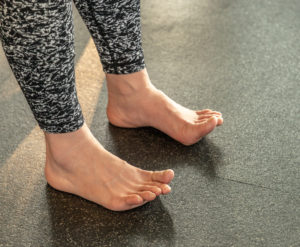
If I asked a ballet dancer whether he or she thought about how they use their feet when they dance, they’d tell me that’s the majority of what they focus on in every class. But how many salsa or bachata or kizomba dancers actually give much thought to how they are using their feet? Chances are, not many of us. Most of us notice our feet when they hurt from dancing too many hours or wanting to break free from being in heels.
Our feet are integral to how we interact with the floor and how the rest of our bodies move. In fact, if the joints and tissues in your feet aren’t moving through their full range of motion with every step, chances are there are a host of things your body is not capable of fully doing. Not able to do your full body motion? Unstable on one leg compared to the other? Hip pain? Lower back pain? Neck pain? All of these can be attributed to how your feet interact with the floor.
Having full body motion and being in control of your weight transfers and changes of direction requires good use of your feet on the floor. Take a side basic, for example. Many newcomers step out each step, almost like marching, by raising the feet directly up off the floor with every step. If this is how your basic looks then you are missing the opportunity to use the strength and unique structures of your feet to have control over every aspect of your movement. From how quickly we respond to a change in distancing or direction from our lead, to slowing down the end of a turn in a controlled manner, to being able to pivot smoothly in one place, to simply being able to create the movements from the ankles upwards that are needed in body motion.
Your feet are marvelous adaptations that are capable of both adjusting their movements to uneven surfaces and giving you the power to propel yourself forward and up into the air. If you’re like me I never gave much thought to my feet when I started salsa. I had an awareness that my feet felt like dead weight at the ends of my legs but I didn’t have the skill set to know how to make use of them to improve my dancing technique. Once I started taking classes at Dance Vancouver that all changed. I was taught that we need to push off the balls of our feet when doing swivels, use the back foot to assist in pivots and make all of our body motion happen through the interaction between the foot and the floor. It wasn’t until I became an Anatomy in Motion practitioner and I learned more than anyone should ever know about foot mechanics that I truly began to appreciate the role of good foot awareness for latin dancing.
Let’s break it down a bit. The foot is supposed to be able to do two things: pronate (where the long arch collapses down to the floor) and supinate (where the long arch sucks up away from the floor). Not only does it need to be able to do these things, it needs to do them well and often. With every step we take each foot needs to cycle through full pronation to full supination and back again. Fail to do enough of either of those and the entire chain of command all the way up to your neck and out to your fingertips is disrupted.
In a side basic, for example, as you step out to the side the foot needs to land on a bent knee with the long arch collapsing, as the knee straightens while you put weight on the other leg the foot then needs to suck that long arch back up again and allow you to push off it to transfer your weight. In swivels your back foot needs to start off pronated and then be able to hit that supination position at the end of your pushoff. Using your back foot against the floor in a corkscrew like fashion while swiveling will help propel you forward and create the body motion you’re looking for.
So what happens to our dancing if we don’t dance by using our feet against the floor? For one, we won’t be as in control of our movements as we’d like. If our feet are behaving like chunks of meat on the ends of our legs they’re not really providing us any value. Slowing down turns, pivoting smoothly, providing the resistance to create body motion, quickly changing direction, and suddenly taking larger steps. All of these skills require using your feet against the floor.
The same thing goes in our daily lives. If our feet aren’t able to access the full range of motion they’re supposed to have while going about our daily lives, then your body has to come up with work-arounds to get you from point A to point B. Those new ways of moving around come with terms and conditions. Issues with foot mechanics can show up in bunions, frequently rolled ankles, Achilles tendon pain, knee pain, lower back pain, and even neck pain, to name a few.
Learning to use your feet while you dance will have immense benefits to your dancing and is a skill that will bring your dancing to a new level. While you’re at it, check in and see if your feet are doing as they’re supposed to in your everyday life. Your future self with thank you.
If you’re interested in checking in with what your feet are doing, check out this video on my Facebook page www.facebook.com/flowmovementtherapy or get in touch at [email protected].
